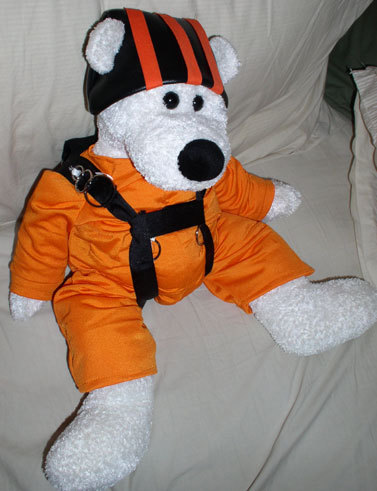Recommended Posts
flyhi 24
QuoteAlso, and I'll try to stay calm here, doing freefly jumps at the A license level is a really bad idea, even at the B level there is a dubiosity factor.
I'm picturing a small girl, just off of AFF, standing there - with an ill fitting student rig, chest strap loose, main lift webs falling off her shoulders, pilot chute barely held in place by a worn out elastic pouch with a big loop of exposed bridle - a protec helmet, well used goggles, a banged around student altimeter, a height of fashion student jumpsuit - who has never gotten on a plane unassisted, has never looked out the door before going, is maxed out just being in freefall and overloaded at pull time - and a hot young stud with 125 jumps, a camera on his helmet and a coach rating is going to take her out, hang on to her harness, hold her head down so she can totally lose sight of the ground and cover 1,000 ft every 3 1/2 seconds - and she's going to do 5 of those and then they're going to turn her loose to jump on her own?
Could not agree more. Nothing scarier to me than to see two people just off AFF, who opt for a two-way freefly ("We're gonna go out and do a sit-fly jump.") with each other. The best that can happen is they don't learn any bad habits.
If I might pontificate, I believe it is a reflection of the times we are in: instant gratification. Every situation most young people see today can be presented, a solution determined, and resolution reached, all within a half an hour, 22 minutes without commercials. If they go out and do a sitfly jump, they feel they have accomplished something, put the check in the box, and tell everyone, "I had an awesome sitfly jump." Been there and done that in a minimum amount of time.
If they opt to go the RW route, they may take 50 jumps or (easily) more, to get the hang of transitioning to the second point, doing a back-in, completing a compressed maneuver without spinning the entire formation, dive to a formation... The feeling of accomplishment is delayed and thus contrary to the immediacy to which we have become accustomed.
I have nothing but the greatest respect for those just off student status who decide to go the RW route first. It is a long and expensive path. And I am really not surprised that more people are choosing an alternate course.
I think that will be the biggest hurdle to implement a plan like yours. It's a great idea, but many will not be willing to put in the time and money to complete it. The money (food for the beast) will walk, and the DZO's will see that. I'm guessing here, but I bet those with a thriving student business will oppose it. And that's a shame.
Deleted 0
Quote
Jump Numbers and Freefall Times
-------------------------------
A - 25 jumps / 5 minutes
B - 50 jumps / 30 minutes
C - 200 jumps / 1 hour
D - 500 jumps / 3 hours
The B license seems a little out of balance.
Does anyone know where the FAI got these ff times vs jump numbers???
A - 25 jumps / 5 minutes = 12 sec/jump
B - 50 jumps / 30 minutes = 36 sec/jump
C - 200 jumps / 1 hour = 18 sec/jump
D - 500 jumps / 3 hours = 21.6 sec/jump
Michele 1
Why not ask at the meeting next week and let us know the reasoning behind it?
Ciels-
Michele
~Do Angels keep the dreams we seek
While our hearts lie bleeding?~
indyz 1
QuoteDoes anyone know where the FAI got these ff times vs jump numbers???
A - 25 jumps / 5 minutes = 12 sec/jump
B - 50 jumps / 30 minutes = 36 sec/jump
C - 200 jumps / 1 hour = 18 sec/jump
D - 500 jumps / 3 hours = 21.6 sec/jump
I think they picked a jump number vs freefall time combination that they felt would give the jumper sufficient freefall experience to go with the privileges of the license, while at the same time not being unfair to those who choose to participate in disciplines with limited freefall time (i.e., CReW, accuracy, swooping, static line instruction, etc).
Quote1. A license is permission to do something, not an award or merit certificate. Any licensing scheme should bear this in mind.
I think that is a very good point. A lot of people get each license just because. There isn't much benefit throughout the whole ABCD program. Let's see what privileges you earn past your A (from SIM)
B - perform night jumps
C - obtain Coach rating and ride with tandem instructors on training/renewal jumps
D - participate in certain demonstration jumps, obtain all USPA ratings
I never got my B license but have the other three. I have jumped at night and with a TM training but didn't apply for the licenses specifically for those reasons. I think they were just landmarks... I like the idea of Big Way and Freefly licenses. I don't like the idea of the added cost/bureaucracy of a system like that though.
Right now if you find out that someone has a D license, all you really know about their skills is that they have survived 200 freefalls. If there were discipline specific licenses, we would more easily be able to judge ones skills/accomplishments. (Let's not forget the Atmosphere Dolphin, which I really know nothing about).
Blue Skies
--------
Benefitting from the 'free capture of verticality.'
QuoteIntent is clear and I hope the USPA takes a hard look at it since there are a LOT of good points in it.
Skratch,
I not only think USPA should take a long hard look at you proposals, but it would be in their,(ours) best interest to bring you in as a consultant. This is the second really great post I have seen this week. (right Hook)
Sparky
sducoach 0
This type of comparison is what's needed before changes are made. Research and evaluation of other systems, experience, and results. Please have DJan take this with her to the BOD meeting. A little "tweaking" and your are on the right track.
Thanks for the effort.
Blues,
J.E.
(the other old guy!)
skr 1
>I not only think USPA should take a long hard look at you proposals
sducoach:
>Please have DJan take this with her to the BOD meeting.
You guys are preaching to the choir (who appreciates it :-) :-)
but if you think USPA should look into this approach, please
tell it to the safety and training committee directly.
sducoach:
>Did this come to you at night in a dream, or ...
No, it's just something I've been proposing for a pretty long
time. This time it was sparked a few months ago by hearing
that they were aligning the USPA licenses with the FAI ones.
Skr
rmsmith 1
QuoteI don't know why licenses were first created, but I assume...
The first step of denying someone of an activity or privilege is to license them.




I know I do not have a lot of experience yet but I see the B license attainable. At this stage you are probably not doing that many hop'n'pops, your are most likely getting as much freefall time as possible. 25 jumps at 10500 to 13500 depending on the fall speed will add up to 25 minutes in no time. I am not disagreeing that the jumper would be more experienced at 75-100 jumps just that it is attainable at 50.
-Sam-
Share this post
Link to post
Share on other sites